

| Nine difficult Nottinghamshire Scopariinae |
| The Scopariinae
are one of the most difficult micromoth groups to
identify to species level and correct identification of
these moths via photographs cannot be 100% relied on. Many people new to moth trapping will often deliberately avoid recording them, but sooner or later succomb to the challenge and give it a go. The purpose of this page, is purely to put the most likely encountered Nottinghamshire Scopariinae, in a single web page and help ease of species comparison. Although some species are quite specific in their habitat requirements, others are regularly attracted to MV lights operated from urban gardens, but these attractively marked moths will turn up virtually anywhere a trap is operated. |
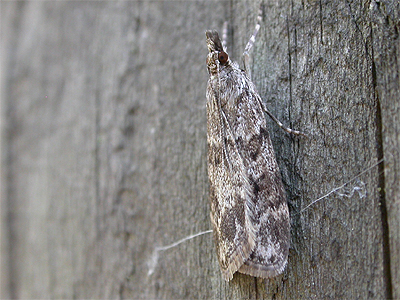 |
|
| .... | ||
| These moths
are readily disturbed from tree trunks and walls during
the day and are certainly well concealed when resting on
Birch. Their life histories are still generally little
known, but some Scopariinae larvae feed on
lichens and mosses growing on walls and tree trunks. Nottinghamshire Scopariinae Historically and according to J. W. Carr's book "The Invertebrate Fauna of Nottinghamshire", many of the Scopariinae have had a rather patchy distribution in Nottinghamshire, or at least recorders seem to have devoted little time to their identification. We have no information available on any other Scopariinae, but at least ten species have occurred, or are still known in Nottinghamshire. Scoparia bisistrigalis was recorded from Sherwood Forest in 1982 (Bee, L. and Sterling, M.J.). The only information regarding other county records is again via Carr's book, when it was recorded from Oxton in 1912 and Epperstone in 1914. The lack of available records is probably more due to the difficulty in actually tracing records of any species in Nottinghamshire, rather than S. bisistrigalis being uncommon. This is not a moth we have recorded personally though, even after trapping within Sherwood Forest for several years, so many records may have been overlooked by ourselves. |
||
| .... |
|
Sherwood Forest also has
a historical record of Eudonia lineola (Brameld, R.E.) from the late 1800's or early
1900's. E. lineola has a largely coastal
distribution in the UK and cannot be completely
discounted from occurring again, as Sherwood has a number
of invertebrates having a similar coastal distribution.
Carr also lists a record of Eudonia
murana for the Mansfield district (Daws). We believe that there are few records of Eudonia pallida. We took this moth at Market Warsop in July 2014, about a week after one was recorded at Attenborough NR by Tim Sexton. There is also a record from Misson Carr in July 2008, but Eudonia pallida must certainly be one of the scarcer species. Certainly classed as either scarce or rare is Eudonia lineola, of which there seem to be very few modern records. |
|||||||||||||||||||||||||||||||||||||||||||||||||||||||||||||||||||||||||||||||||||||||||||||||||||||||||||||||||||||||||||||||||||||||||||||||||||||||||||||
| .... | ||
| Scoparia
subfusca is is a quite distinctive moth by Scopariinae
standards and fairly large in comparison to the other
Nottinghamshire Scopariinae. Faded or worn
examples of S. ambigualis will be often be
mistaken for S. subfusca, but definite S.
subfusca are quite distinctive. This moth is
certainly scarce around the Sherwood Forest area, but
there has been a recent spate of records over the past
few years. Both our own records have come during July. Scoparia ambigualis is often the first of the Scopariinae to appear on the wing. A very common moth found in a wide range of habitats, the first adults usually appear from mid-May and continue to fly for much of the Summer. The variability in markings, coupled with the presence of very worn specimens as the Summer progresses, means that S. ambigualis will often be mistaken for other species and this is usually where the identification problems associated with Scopariinae will begin. Scoparia pyralella is another common moth, flying during June and July. S. pyralella is one of the more distinctive of the Scopariinae and some of the darker markings on the wings are in-filled with light brown, including the figure eight shaped Discal spot. This is another common moth frequenting a range of habitats and is easily disturbed from its daytime resting place. |
||
| Scoparia and Eudonia species - dorsal views | ||||
| .... | ||||
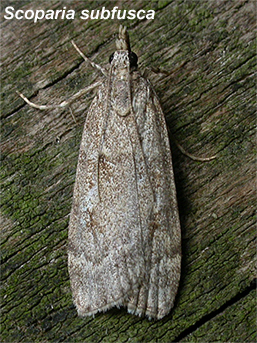 |
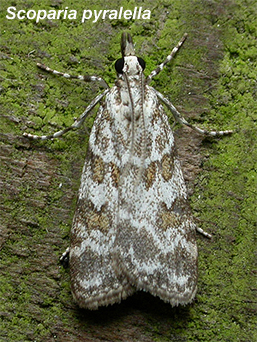 |
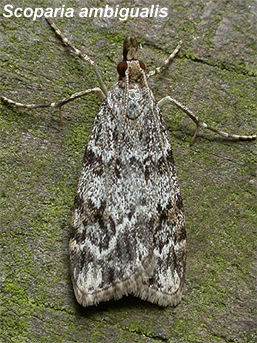 |
||
| .... | ||||
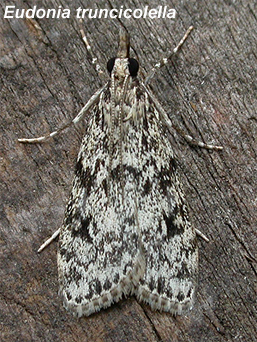 |
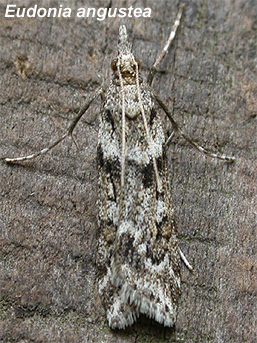 |
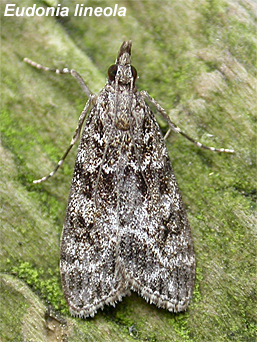 |
||
| .... | ||||
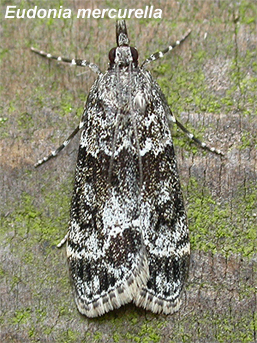 |
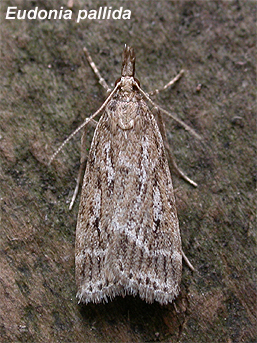 |
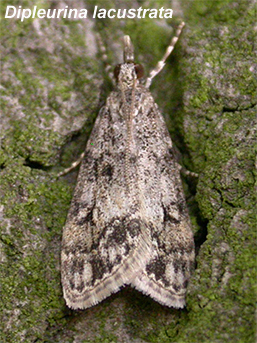 |
||
| .... | ||||
| Eudonia
truncicolella is a difficult moth to
seperate from S. ambigualis and poorly marked E.
mercurella. It usually occurs in large woodlands and
it has become quite regular in recent years at Sherwood
Forest, but may not be that widespread across the county. Eudonia angustea is thankfully the easiest of all our Scopariinae to identify, but identification is easiest based on resting posture and wing shape. The forewings are more pointed and appear to be held more closely to the body, giving the whole moth a slimline posture. E. angustea is readily attracted to lighted windows in most urban locations and flies till quite late in the year. Eudonia lineola is sometimes referred to as appearing 'scratchy' and seems to be genuinely rare in Nottinghamshire and at the time of writing, there appear to be no traceable modern records. One came to MV light at Ransom Wood near Mansfield in September 2023. Eudonia mercurella often has an overall darker appearance and well marked individuals tend to visibly stand out as something different among large numbers of other Scopariinae in the trap. Our records have E. mercurella as flying between July and September. Eudonia pallida is supposedly one of the easiest to identify, but identification is made more difficult when specimens are worn. When fresh (as in the photographs) there should be no problem with ID.Eudonia lacustrata (formerly Dipleurina lacustrata) is a reasonably distinctive moth and fairly easy to recognise once some familiarity with other Scopariinae has been gained. Usually slightly smaller and with an obvious pale area across the centre of the forewings. Some specimens can occasionally have a sandy background colouration, but this is unusual in our experience. Occurs commonly in a variety of situations including gardens from June to September. |
||||
| Scoparia and Eudonia species - lateral views | ||
| .... | ||
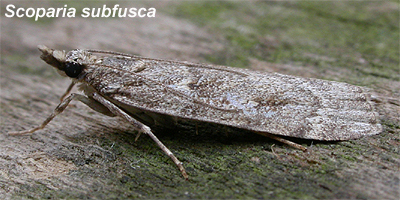 |
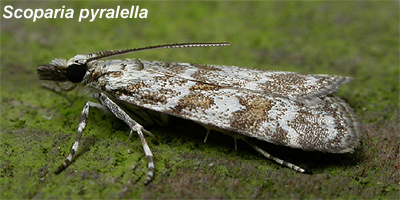 |
|
| .... | ||
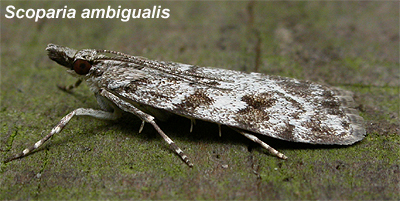 |
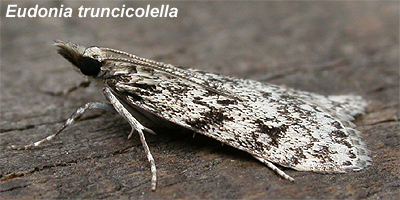 |
|
| .... | ||
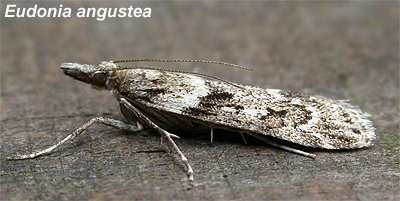 |
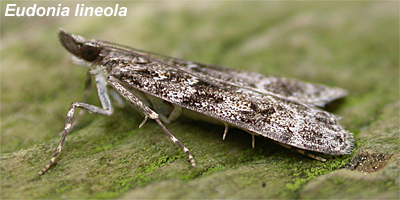 |
|
| .... | ||
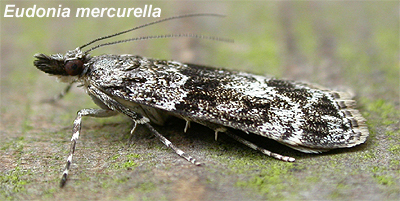 |
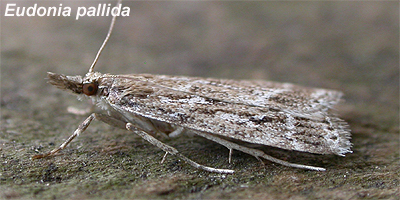 |
|